Best Practices for Maintaining a Healthy Lawn Ecosystem
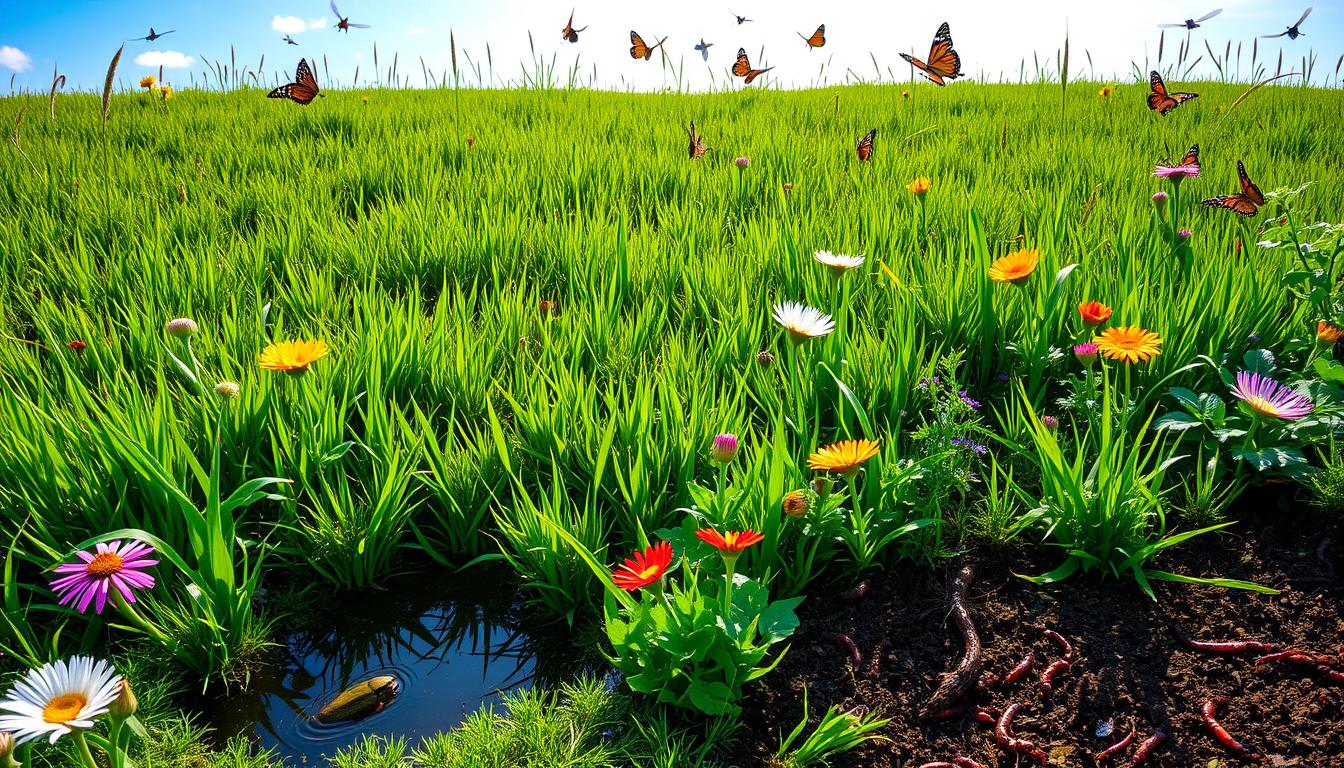
Lawns cover only 2% of U.S. land but use more water than any crop.
This shows how much water lawns use. As a homeowner, I know we all want a green lawn. But, we must care for our lawns in a way that protects water and supports local wildlife.
In this guide, I’ll share the best ways to have a healthy, chemical-free lawn. We’ll talk about soil tests, adding good microbes, picking the right grass, and using natural ways to control weeds and pests. You’ll learn how to make your lawn beautiful, safe for your family and pets, and good for the planet.
Key Takeaways
- Lawns have a significant water consumption impact, requiring more irrigation than agricultural crops.
- Adopting organic and sustainable lawn care practices can protect natural waterways and support local biodiversity.
- A comprehensive approach to lawn maintenance includes soil testing, introducing beneficial microorganisms, and selecting the right grass varieties.
- Natural weed and pest control methods can be effectively implemented to create a thriving, chemical-free lawn.
- Sustainable mowing practices and water conservation strategies are essential for maintaining a healthy lawn ecosystem.
Understanding the Importance of a Healthy Lawn Ecosystem
Keeping our lawns healthy is key for a green outdoor space. Organic lawn care and avoiding synthetic chemicals bring many benefits. These benefits go beyond our yards.
Benefits of a Chemical-Free Lawn
Choosing not to use harsh chemicals makes our homes safer. It’s better for our families, pets, and wildlife. Chemical-free lawns also help the planet by reducing carbon dioxide and preventing soil erosion.
These green spaces need less water than treated lawns. This helps save water and supports conservation efforts.
Supporting Local Biodiversity
A chemical-free lawn is a home for local wildlife. It attracts beneficial insects like pollinators. These insects are vital for our ecosystem’s health.
This supports the food chain and keeps our environment balanced. Biodiverse lawns also improve soil health. The different plants and insects help make the soil better.
“Maintaining a healthy lawn ecosystem is not only visually appealing but also plays a crucial role in supporting the overall health of our local environment.”
By choosing sustainable landscaping, we help our communities. An eco-friendly yard makes a big difference for a greener future.
Conducting a Soil Test and Assessing Your Lawn
A healthy lawn starts with healthy soil.
Begin by getting a detailed soil test to find out what nutrients your lawn needs. This will help you choose the right organic amendments to make your soil better and help your grass grow.
Also, take a close look at your lawn to spot any problems. Look for bare spots, weeds, or signs of pests or diseases. Knowing what’s going on with your lawn helps you fix it and keep it healthy.
Understanding Your Soil Composition
Soil is made up of sand, silt, and clay. The best soil for lawns, called loamy soil, holds moisture and nutrients well. It doesn’t get too wet. Knowing your soil type helps you pick the best amendments to improve it.
Optimal Soil pH for Lawn Health
Grass and most plants like slightly acidic to neutral soil, with a pH of 6.0 to 7.5. The pH scale goes from 0 (acidic) to 14 (alkaline). It affects how well plants get nutrients and how microbes work in the soil. A soil test shows your soil’s pH and tells you what to add to get it right.
Essential Nutrients for Lawn Growth
Soil tests check for important nutrients like nitrogen, phosphorus, potassium, and micronutrients. These nutrients are key for a strong lawn. If they’re off, your lawn might not do well. The test will tell you how to fix any problems.
By testing your soil and checking your lawn, you’re setting up your lawn for success. You’ll know how to care for it organically. This will make your lawn healthy and strong without using chemicals.
Preparing Your Lawn for Organic Care
Starting an organic lawn care routine needs some prep work upfront. But the benefits you’ll see in the long run make it all worth it. Begin by mowing your lawn to about 2 inches tall. This height makes it easier to remove weeds and deal with thatch buildup.
Removing Weeds and Thatch
Weeds can be a big problem, but you can manage them with effort. Start by pulling out any weeds you see, making sure to get the whole root. Also, get rid of any extra thatch. Too much thatch blocks water and nutrients, hurting your grass’s growth.
Aerating the Soil
Then, use a power aerator to pull up small soil plugs all over your lawn. This soil aeration lets organic treatments get in deeper and helps your grass roots grow stronger. Organic lawns need up to 30% less water because they have deeper roots and healthier soil.
After these steps, your lawn is set to enjoy the perks of organic care. People who switch to organic lawn care say their lawns look as good as ever, without using harsh chemicals.
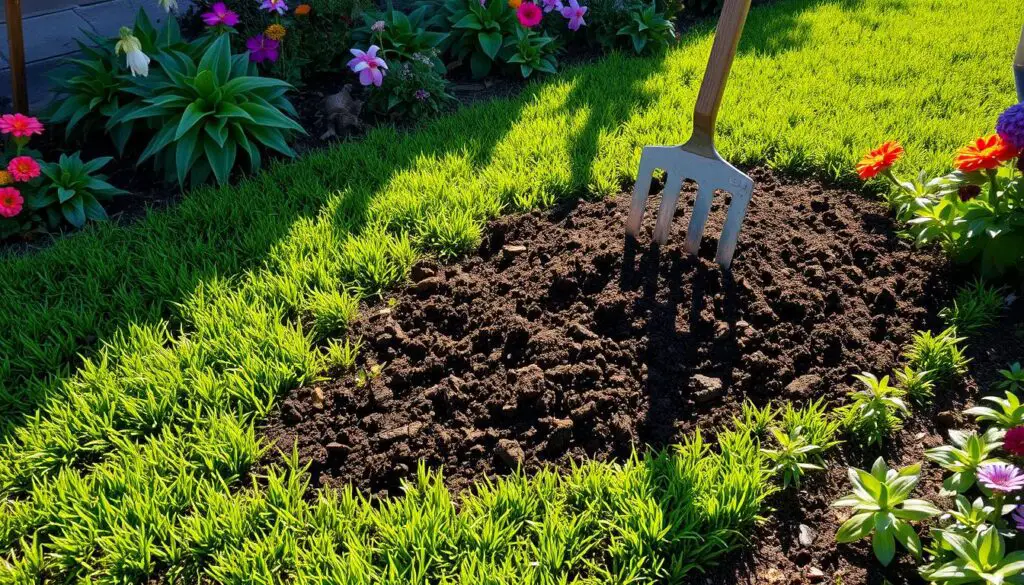
“Organic lawn care can be time-consuming at first but results in a thriving lawn over time.” – Sam Masser, author of The Mowers Guide
Introducing Beneficial Microorganisms to Your Lawn
Keeping your lawn healthy is key for a great outdoor space. Organic lawn care focuses on a strong soil ecosystem. This is done by adding beneficial microorganisms.
These tiny helpers are crucial for your lawn’s health and strength.
The Role of Compost and Compost Tea
Using compost or compost tea on your lawn is a smart move. They bring in good bacteria, fungi, algae, and nematodes. These work together to make your soil better, help nutrients, and fight off bad bugs.
Compost tea is a liquid made from compost. It’s great for adding these good guys to your lawn. It helps your soil become a lively, healthy place. This means your grass will be stronger and you’ll use fewer chemicals.
| Beneficial Microorganisms | Benefits to Lawn Ecosystem |
|---|---|
| Bacteria | Decompose organic matter, improve soil structure, and suppress plant pathogens. |
| Fungi | Enhance nutrient cycling, form symbiotic relationships with plant roots, and protect against diseases. |
| Algae | Improve soil fertility, increase water-holding capacity, and contribute to soil aggregation. |
| Nematodes | Prey on harmful pests, enhance nutrient availability, and aerate the soil. |
By adding compost and compost tea, you make your soil a healthy home. This organic way helps your lawn grow strong without chemicals. It’s good for your lawn and the planet.
Selecting the Right Grass Variety for Your Climate
Choosing the right grass variety is key for a healthy, organic lawn. Each type of grass has its own needs and looks. This lets homeowners create a beautiful, lasting outdoor space.
Cool-Season Grass Options
In cold winters and mild summers, cool-season grasses like Kentucky bluegrass, fine and tall fescue, and perennial ryegrass are great. They stay green and lush in the Northeastern United States, spring and fall.
Warm-Season Grass Options
Warm-season grasses like Bermuda grass, zoysia grass, and St. Augustine grass do well in hot summers and mild winters. They’re perfect for the Southern states and handle drought better than cool-season grasses.
Think about temperature, water needs, and native species when picking grass. This ensures a balanced and strong ecosystem. By matching your grass to your climate and soil, you’ll have a beautiful, easy-to-care-for lawn.
| Grass Variety | Climate Preference | Maintenance Level | Drought Tolerance |
|---|---|---|---|
| Kentucky Bluegrass | Cool-Season | High | Moderate |
| Tall Fescue | Cool-Season | Moderate | Good |
| Bermuda Grass | Warm-Season | Moderate | Excellent |
| Zoysia Grass | Warm-Season | Moderate | Excellent |
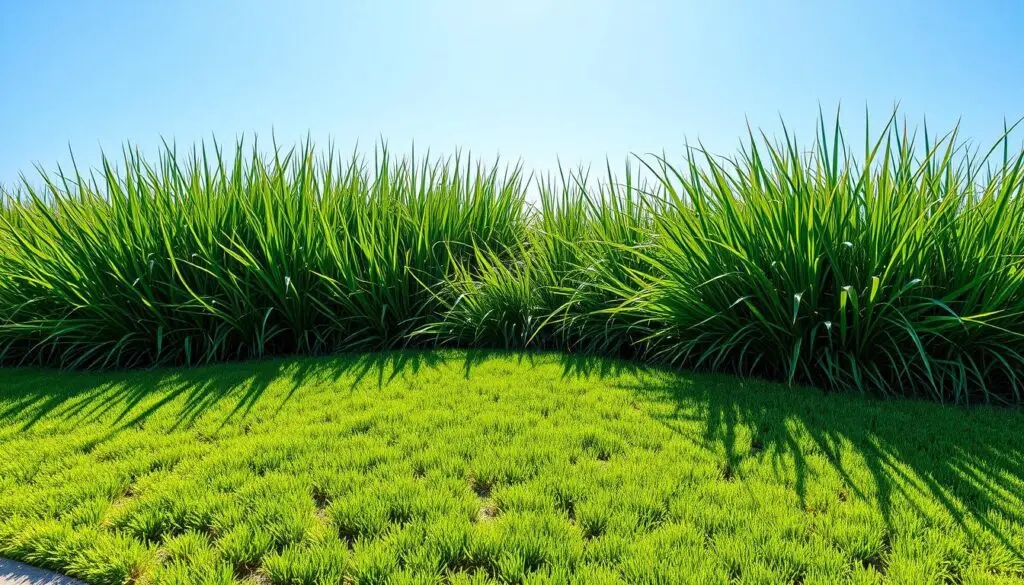
“Selecting the right grass type is crucial for rejuvenating a tired lawn, with considerations for local climate, soil condition, and maintenance preferences to ensure a vibrant and resilient outdoor space.”
Knowing the needs of cool-season and warm-season grasses helps homeowners choose wisely. Whether in the Midwest, Northeast, or South, there’s a grass for your climate. It will make your outdoor space lush and inviting for years.
Organic Lawn Fertilization Techniques
Keeping your lawn healthy doesn’t need harsh chemicals. Instead, organic lawn fertilizers give your grass the nutrients it needs. They also help create a greener, more eco-friendly space.
Compost is a top choice for organic fertilizers. It’s packed with nutrients that make your soil better. This lets your lawn soak up nutrients more easily. Compost tea, a liquid made from compost, is another great way to feed your grass.
Natural slow-release fertilizers like seaweed, bone meal, or feather meal are also good. They give your lawn nutrients slowly, so it can use them well. This way, your grass gets what it needs without the risk of losing nutrients to runoff.
| Organic Lawn Fertilizers | Advantages |
|---|---|
| Compost | Improves soil structure and texture, provides a variety of essential nutrients |
| Compost Tea | Delivers beneficial microorganisms and nutrients directly to the lawn |
| Slow-Release Fertilizers | Offer a steady supply of nutrients, reducing risk of runoff |
Using organic lawn fertilization techniques helps your lawn grow strong. It also keeps your ecosystem healthy. This way, your lawn is good for your family, pets, and the local wildlife.
“Organic lawn care promotes sustainability and avoids synthetic chemicals, leading to a safer environment for families and pets to enjoy the outdoors.” – Leah, composting specialist
Embracing Organic Weed Control Methods
Keeping your lawn weed-free can be tough, but it’s doable with organic lawn care. The right steps can help you manage weeds without harsh chemicals. Focus on stopping weeds before they start and use natural solutions.
Preventative Measures
Preventing weeds is the best way to keep your lawn weed-free. Regular overseeding and the right mowing height are key. Also, using corn gluten meal in spring helps crowd out weeds and keeps your lawn dense.
Organic Weed Killers
For weeds already growing, pulling them out works well. Tools like the Cobrahead weeder make this easier. Organic weed killers with citrus oil or vinegar also work great. They kill weeds without harming your lawn.
Weeds often show soil problems. Fixing these issues helps prevent weeds and makes your lawn healthy. This creates a balanced, organic weed control environment.
“Weeds are not just a nuisance, but they can also be indicators of soil health. By addressing the root causes, we can create a lawn that is both beautiful and ecologically balanced.” – Leah, soil health specialist
Using weed prevention and natural weed control solutions keeps your lawn healthy and green. With some effort and the right methods, you can have a beautiful, organic weed control lawn. It’s good for your family and the planet.
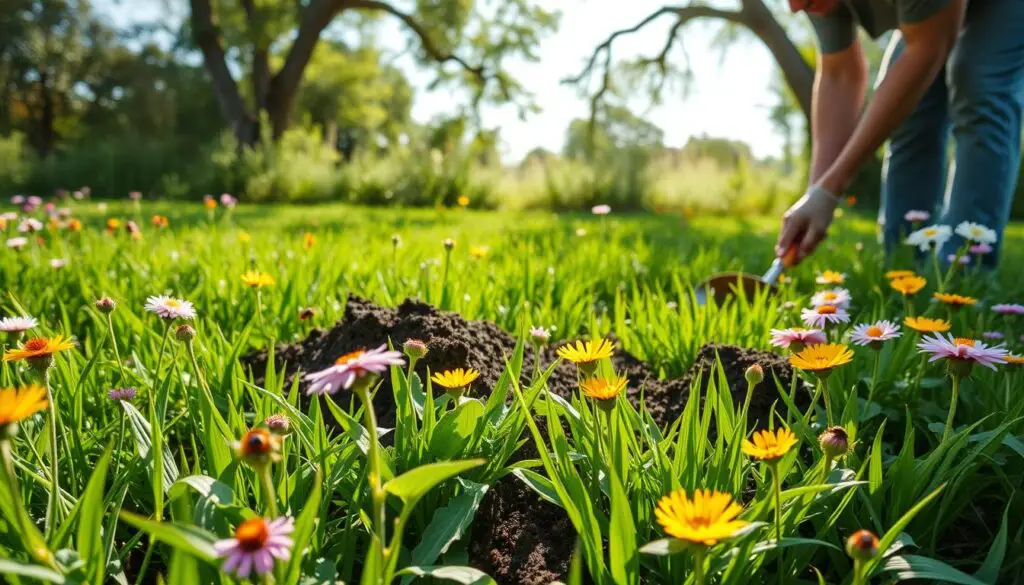
Managing Pests Organically with a Healthy Lawn Ecosystem
Keeping your lawn healthy is key to controlling pests naturally. By welcoming beneficial insects, we use nature’s ways to fight pests. Adding flowering plants helps attract ladybugs and lacewings, which eat pests.
For grub problems, nematodes are a big help. These tiny worms eat pests without harming the lawn. For tough cases, neem oil and diatomaceous earth can be used carefully to keep your lawn healthy.
“Creating a balanced ecosystem where pests are naturally controlled is the essence of organic lawn care.” – Richard, ecology professional
Using these methods means no more endless fight against pests. Your lawn will be lush and vibrant, working in harmony with nature.
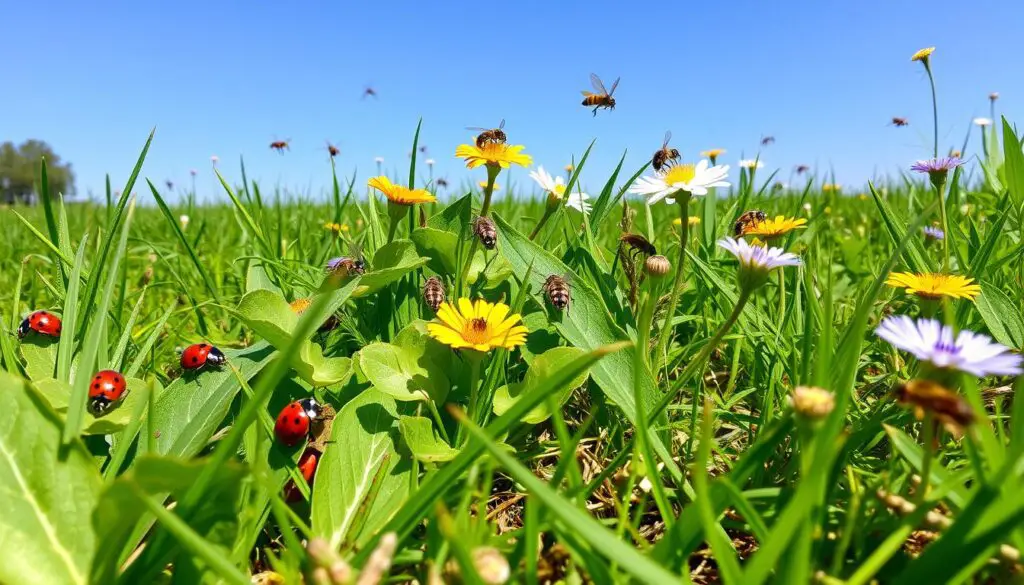
Encouraging Beneficial Insects
To have a healthy lawn, we need to attract beneficial insects. These insects, like ladybugs and lacewings, control pests like grubs and beetles without chemicals.
- Plant native, flowering plants for nectar and pollen.
- Put up birdhouses and bee hotels for natural predators.
- Stay away from broad-spectrum insecticides to keep the ecosystem balanced.
| Beneficial Insects | Prey on Common Lawn Pests |
|---|---|
| Ladybugs | Aphids, mites, and other small insects |
| Lacewings | Aphids, mealybugs, and insect eggs |
| Predatory Spiders | Grubs, caterpillars, and other crawling pests |
By creating a diverse and balanced lawn, we reduce the need for chemicals. This way, your outdoor space will be lush and healthy, living in harmony with nature.
Water Conservation Strategies for a Healthy Lawn Ecosystem
Keeping a lawn green while saving water is a challenge. But, it’s doable with the right gardening tips. Organic lawns need less water because their roots grow deeper and soil is healthier.
One key strategy is to water deeply but infrequently. This makes grass roots grow deeper, needing less water on the surface. I use a rain gauge to check how much water my lawn gets. I add more water if needed, aiming for 1-2 inches a week during growing seasons.
I’ve also chosen drought-tolerant grass varieties for my lawn. These grasses are made for dry weather, using less water. Plus, I’ve set up drip irrigation systems to water roots directly, cutting down on evaporation and runoff.
“Sustainable lawns can reduce water usage by up to 50% compared to traditional lawns.” – Sam, author
These steps have kept my lawn healthy and green while saving water. It’s good for my garden and the planet.
Small changes can lead to big improvements in lawn care. With some effort and the right methods, we can all have beautiful, eco-friendly lawns while saving water.
Proper Mowing Practices for Organic Lawns
To keep your organic lawn healthy and lush, mowing is key. Mow at the right height for your grass and often enough. This way, the grass heals fast and fights off diseases.
For best results, set your mower to 3-3.5 inches all season. In hot weather, raise it to 4 inches to keep the grass moist. Finish the season with a 2.5-inch cut to get ready for winter.
Change how often you mow based on your grass’s growth. This is usually once a week when it’s growing fast. Make sure your mower blades are sharp. Dull blades tear the grass, causing uneven cuts and more disease.
| Mowing Height | Mowing Frequency | Blade Sharpness |
|---|---|---|
| 3-3.5 inches | Weekly | Sharp |
| 4 inches (during heat) | Adjust to growth rate | Cleaned and sharpened regularly |
| 2.5 inches (final cut) | As needed | – |
Don’t forget to leave the grass clippings on your lawn. They add nutrients and organic matter, cutting down on chemical fertilizers.
By mowing right, your lawn will be lush and weed-resistant. It will also support a healthy ecosystem. Just remember to mow at the right height, with sharp grass clippings, and regularly.
The Rewards of Maintaining a Healthy Lawn Ecosystem
Keeping a lawn healthy with organic and sustainable methods brings many benefits. Switching to a chemical-free yard makes it safer for my family, pets, and wildlife. It also helps my lawn become self-sustaining, needing less water and care over time.
My eco-friendly lawn does more than look good. It helps lower carbon dioxide levels by trapping CO2. It also catches dust and pollutants, improving air quality and helping with breathing problems. Plus, it slows down stormwater runoff, preventing soil erosion and reducing flood risks.
Working on an organic lawn is rewarding. I get to enjoy a beautiful, green space that fights climate change and benefits my community. By choosing sustainable lawn care, I create a healthier home and help the planet.
FAQ
What are the benefits of maintaining a healthy lawn ecosystem?
How do I conduct a soil test and assess the current state of my lawn?
What are the steps for preparing my lawn for organic care?
How can I introduce beneficial microorganisms to my lawn?
How do I choose the right grass variety for my climate?
What are some organic lawn fertilization options?
How can I manage weeds without using chemicals?
How do I manage pests organically?
How can I conserve water in my organic lawn?
What are the best mowing practices for an organic lawn?
Source Links
- https://www.ecolandscaping.org/04/installing-and-maintaining-landscapes/lawn-care/ecological-lawn-care-2/
- https://kappslawn.com/keeping-your-lawn-healthy-all-year-round-seasonal-tips-for-lawn-care-success/
- https://lawnlove.com/blog/steps-eco-friendly-lawn-care/
- https://theturfgrassgroup.com/tiftuf-bermuda/4-ways-having-a-healthy-lawn-is-good-for-the-environment/
- https://extension.umn.edu/lawn-care/environmental-benefits-lawns
- https://www.thecommons.earth/blog/biodiverse-lawns-an-eye-catching-way-to-make-your-home-more-sustainable
- https://fortsmithlandscaping.com/blog/soil-testing-in-lawn-care/
- https://thegrassoutlet.com/grass-care/before-you-plant/soil-testing/?srsltid=AfmBOorPOW0WTHWOBuD7HZ1Ks9DeU5mkBYMGG0ISBG39N9zzeOX7SWKA
- https://blog.davey.com/how-to-perform-a-soil-test-and-why-you-need-one/
- https://www.thisoldhouse.com/lawns/21015220/tips-for-a-lush-organic-lawn
- https://www.forbes.com/home-improvement/lawn-care/organic-lawn-care-guide/
- https://www.smilinggardener.com/soil-food-web/how-to-make-effective-microorganisms/
- https://ecolawnutah.com/how-to-nurture-microorganisms-for-a-better-lawn/
- https://www.naturesselect.com/blog/the-role-of-microorganisms-in-your-lawns-ecosystem/
- https://doehlinglandscape.com/blog/choosing-the-right-grass-type-for-your-lawn
- https://erbertlawns.com/lawn-care-tips/choosing-the-right-grass-type/
- https://thomasonlawns.com/blog/the-benefits-of-choosing-the-right-grass-type-for-your-climate-and-soil
- https://lawnlove.com/blog/organic-lawn-care-how-to-grow-chemical-free-grass/
- https://www.organiclawns.net/blog/organic-lawn-care-fertilization-techniques/
- https://scape-abilities.com/essential-organic-lawn-care-strategies-for-healthy-grass-maintenance/
- https://pittsburghearthday.org/stop-worrying-and-embrace-those-weeds-for-an-eco-friendly-garden/
- https://www.heirloomsoul.com/blog/how-to-suppress-weeds-organically-without-chemicals
- https://www.pestshare.com/lawn-pest-management/
- https://thegreenqueen.com/harmony-with-nature-green-queens-guide-to-organic-lawn-care-and-natural-pest-management/
- https://www.the71percent.org/lawn-care-practices-that-promote-water-conservation/
- https://blog.propartsdirect.net/post/Cultivating-Sustainability-Eco-Friendly-Lawn-Changes-for-Water-Conservation
- https://pjcorganic.com/2023/06/25/proper-mowing-protocol/
- https://scotts.com/en-us/seasonal-tips/smart-ways-to-maintain-an-eco-friendly-lawn.html
- https://paradisescapes.com/the-ultimate-guide-to-organic-lawn-care-simple-tips-for-a-healthy-lush-yard/
- https://scotts.com/en-us/seasonal-tips/the-environmental-benefits-of-your-lawn.html
- https://lawnpride.com/how-lawn-fertilization-can-have-positive-effects-on-the-environment/
- https://www.naturesselect.com/blog/the-six-benefits-of-having-a-healthy-lawn/

